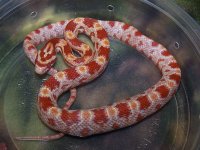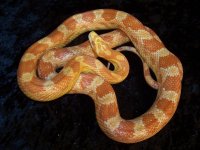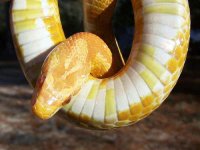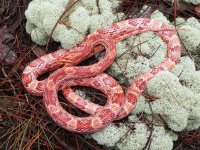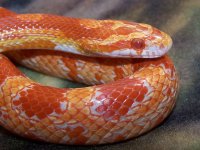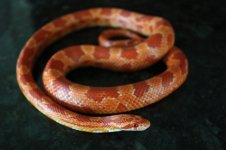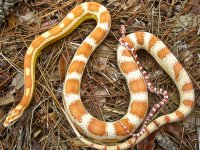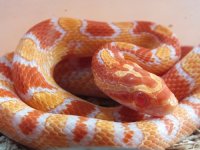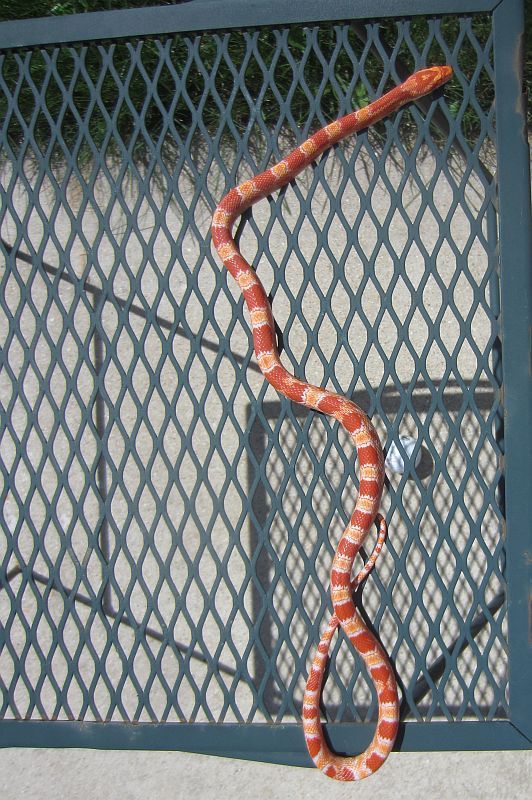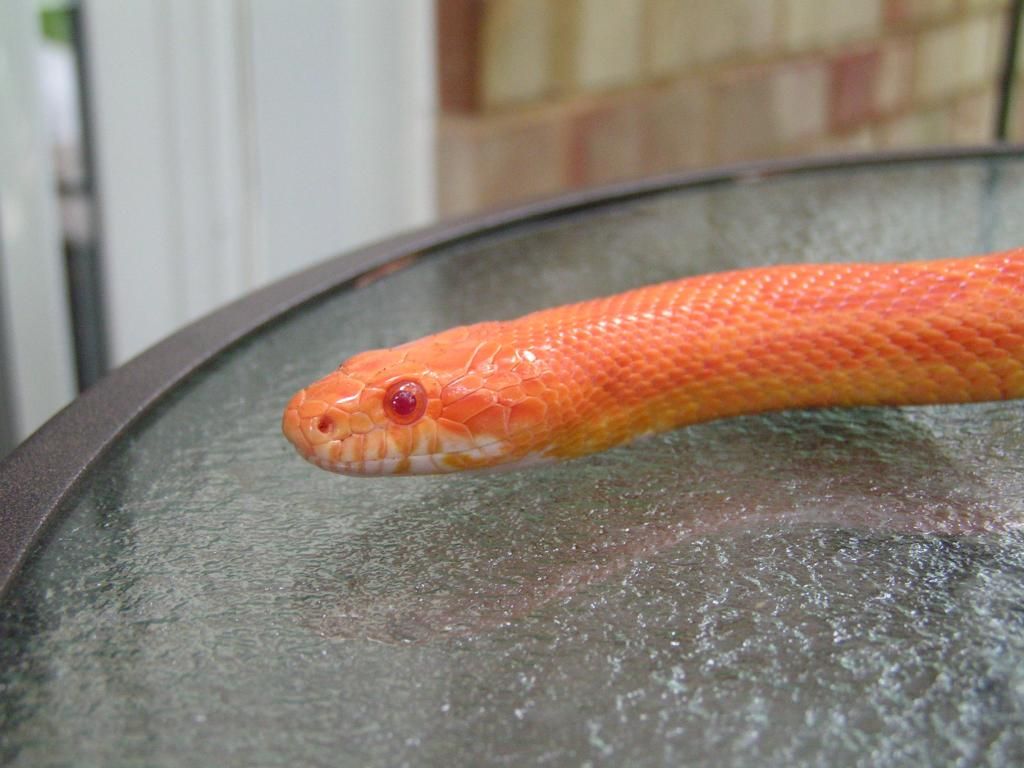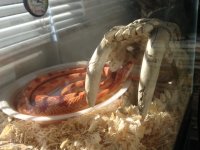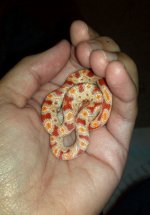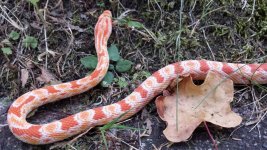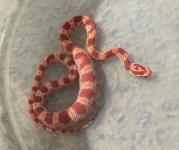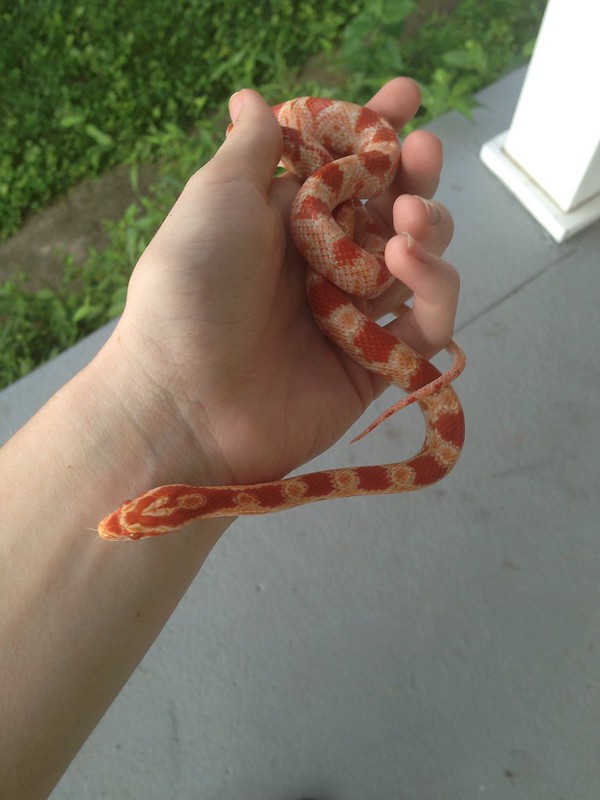Susan
Go Ahead, Make My Day!
GENETICS:
Homozygous Amelanism (aa) - Simple recessive
Trade Names:
Amel
Albino
Red Albino
Selectively Bred Variations
Candycane
Reverse Okeetee
Fluorescent Orange
High White Reverse Okeetee
Sunglow
The following was quoted directly from Rich Zuchowski's SerpenCo website and I couldn't think of a better description and history than this:
"Realistically, this is the snake that started it all, as far as cultivars in corn snakes are concerned. From one wild caught animal collected in North Carolina back in the early '50s, and subsequent breeding efforts by Dr. Bernard Bechtel, the albino corn snake became THE reason many people started working with and breeding corn snakes. To the best of my knowledge, this was the first albino reptile that became available commercially and quite probably was the spark that started people thinking about actually breeding reptiles rather than as disposable commodities easily replaceable from wild caught stock.
As in all of the cultivars of corn snakes, this one is extremely variabile in appearance. Some of the extremes have taken on generic names of their own in order to classify a particular color variation. Although the generic variations are not genetically predictable traits, a person can reliably expect to get a high percentage of offspring resembling the parents that were themselves usually the product of selective breeding. Often, more mundane looking individuals will result in the offspring, but every once in a while, something completely different and unexpected may arise that will go off on a tangent of it's own with a new generic name applied to it. Such is the excitement of breeding these animals when the genetic potentials unfold before your very eyes.
Individuals will vary from almost uniform red orange with indistinct blotching to an orangish white background with red blotches. Varying shades of yellows in the background and blotches can modify the colors quite a bit, making predicting what any particular individual will turn out looking like nearly impossible to do. One trait that is ALWAYS present, of course, is the red eyes of all amelanistic corn snakes."
Homozygous Amelanism (aa) - Simple recessive
Trade Names:
Amel
Albino
Red Albino
Selectively Bred Variations
Candycane
Reverse Okeetee
Fluorescent Orange
High White Reverse Okeetee
Sunglow
The following was quoted directly from Rich Zuchowski's SerpenCo website and I couldn't think of a better description and history than this:
"Realistically, this is the snake that started it all, as far as cultivars in corn snakes are concerned. From one wild caught animal collected in North Carolina back in the early '50s, and subsequent breeding efforts by Dr. Bernard Bechtel, the albino corn snake became THE reason many people started working with and breeding corn snakes. To the best of my knowledge, this was the first albino reptile that became available commercially and quite probably was the spark that started people thinking about actually breeding reptiles rather than as disposable commodities easily replaceable from wild caught stock.
As in all of the cultivars of corn snakes, this one is extremely variabile in appearance. Some of the extremes have taken on generic names of their own in order to classify a particular color variation. Although the generic variations are not genetically predictable traits, a person can reliably expect to get a high percentage of offspring resembling the parents that were themselves usually the product of selective breeding. Often, more mundane looking individuals will result in the offspring, but every once in a while, something completely different and unexpected may arise that will go off on a tangent of it's own with a new generic name applied to it. Such is the excitement of breeding these animals when the genetic potentials unfold before your very eyes.
Individuals will vary from almost uniform red orange with indistinct blotching to an orangish white background with red blotches. Varying shades of yellows in the background and blotches can modify the colors quite a bit, making predicting what any particular individual will turn out looking like nearly impossible to do. One trait that is ALWAYS present, of course, is the red eyes of all amelanistic corn snakes."
Attachments
Last edited:

